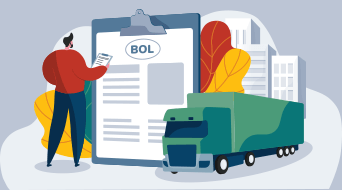House Bill of Lading vs. Master Bill of Lading: What SMB Shippers Need To Know
So, maybe you've been handling your company's LTL freight shipping for a while and are well aware of the Bill of Lading (BOL), which just means "bill of freight." But, did you know there are two kinds of BOLs? In addition to the House Bill of Lading exclusively pertaining to your individual shipment, there is also a Master Bill of Lading required when several shipments, perhaps from several sellers, are being combined for transport. Here, we'll discuss the difference between these two types of BOL and how each are used.
What is a bill of lading?
A bill of lading is only one of the numerous documents you'll be using in international freight shipping. A BOL serves various purposes, primarily including these three functions:
- The BOL is the receipt for the cargo transfer from party A to party B.
- The BOL serves as a written agreement that one party will move cargo to a given location for someone.
- If there is no formal contract for the shipment, the BOL serves as the actual contract for carrying the freight.
- A BOL can be used as a degree of proof of ownership of the cargo and may even indicate the right to transfer ownership in some cases:
- A BOL labeled as negotiable constitutes such evidence and can, in some cases, be understood to indicate that the property may be sold and resold.
- A BOL without the negotiable label or that explicitly states that the status of the cargo is non-negotiable indicates that the ownership of the freight cannot be transferred through transactions based on ownership by virtue of the BOL alone.
For Self-Education on BOLs: See the Unishippers blog for numerous educational articles about BOLs. The collection includes a wealth of articles offering detailed explanations of the many functions, terms, instructions, benefits, and common problems involved with BOLs, the role of BOLs in recovering lost freight or filing loss or damage claims, and much more.
Bill of Lading Types
There are actually over a half dozen types of bill of lading. The two types of BOL that you will encounter when your shipment becomes part of a consolidated accumulation of freight during transport from the point of origin to the final destination are:
1. House BOL
The house bill of lading (HBL) is a BOL provided by a non-vessel operating common carrier (NVOCC) or a freight forwarder (shipping management agent such as a 3PL) for the cargo owner/shipper (seller, exporter) as a receipt for the items being shipped. The carrier ships the freight by land, sea or air. The freight agent may have a carrier service in-house or work with outside carriers.
2. Master BOL
The master bill of lading (MBL) is a BOL issued by the carrier. It is effectively the carrier's contract with the freight agent, or with the exporter directly, for the transport of the shipment. When the carrier receives the freight and consolidates it with other cargo from other shippers, the company, an MBL is then generated for the agent or freight owner who ordered the shipping.
Using a House BOL or a Master BOL
Here is how these two different BOLs work when shipping internationally:
- House BOL: A seller needs to send a load of freight to Spain and asks carrier company A to pick up the shipment. Carrier A transports the freight from the seller's location and creates an HBL for the seller as a receipt confirming they've received the freight from the shipper.
- Master BOL: Then, carrier A chooses carrier B to move the seller's cargo and freight from several other shippers in the same load. Carrier B picks up all the consolidated freight loads going to Spain from carrier A and gives an MBL to carrier A as a receipt for all the items picked up for all the sellers with goods going to Spain. That MBL also constitutes a contract with carrier A for the transport of the shipment (which consists of multiple shippers' freight loads combined).
HBL and MBL in a Nutshell
An HBL is a receipt from a carrier to the individual seller, whereas an MBL is a receipt from a carrier to multiple sellers or their freight agents when a carrier combines the separate freight loads from individual shippers to form a single larger shipment to the common destination to which all the consolidated freight loads are being sent.
For Self-Education on International Shipping: See the Unishippers guide to help you achieve efficient international shipping. These include detailed information on international shipping documentation, customs issues, carrier procedures, and much more for air, ocean and cross-border shipping.
Unishippers for International Shipping Service
Unishippers is a full-service third-party logistics (3PL) services providers. We provide freight shipping solutions throughout the U.S., Mexico, Canada and overseas. Our vast network of local, regional and national carriers and shipping customers means we provide customers with maximum efficiency, time and money savings, convenience and of course BOL assistance like common mistakes and how to prevent them.
We're Here To Help with Freight Shipping
For a domestic or international freight shipping quote or information about 3PL services, get a shipping consultation today!


